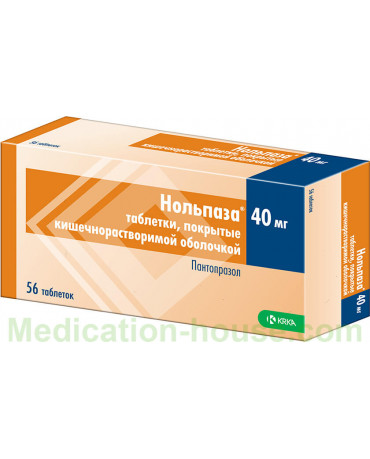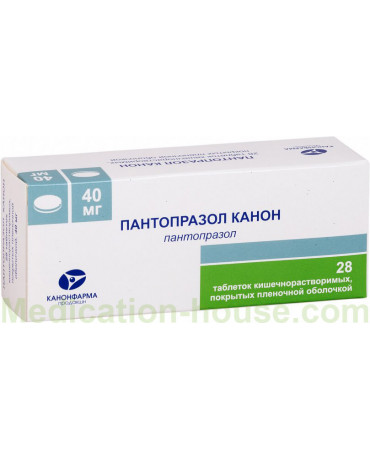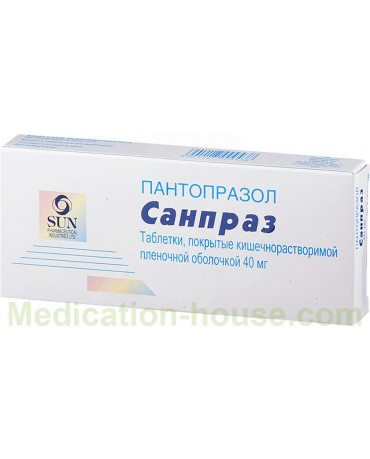Instruction for Panum
Reed more and buy Panum here
Release form and composition
Dosage forms of Panum release:
enteric-coated tablets: from yellow to light yellow, biconvex, round (10 pcs. in blisters, in a cardboard bundle of 1 or 2 blisters);
Composition of 1 tablet:
active substance: pantoprazole - 40 mg (pantoprazole sodium sesquihydrate - 45.1 mg);
auxiliary components: mannitol, crospovidone, 30% simethicone emulsion, calcium stearate, anhydrous sodium carbonate, povidone, sodium hydroxide, Opadry dye acrylosis yellow 93O92052 (type C methacrylic acid copolymer, talc, titanium dioxide, triethyl citrate, colloidal sodium dioxide, silica yellow iron oxide, sodium lauryl sulfate), Opadry YS-1R-7006 dye transparent (macrogol 400, hypromellose 5cP, macrogol 6000).
Pharmacodynamics
Panum is one of the proton pump inhibitors (H + / K + -ATPase). By lowering the basal and stimulated secretion, it blocks the final stage of hydrochloric acid secretion, regardless of the nature of the stimulus.
In case of duodenal ulcer associated with Helicobacter pylori, a decrease in gastric secretion leads to an increase in the sensitivity of microorganisms to drugs with an antibacterial effect. It does not affect the motility of the gastrointestinal tract. Normalization of secretory activity occurs 3-4 days after the end of use.
Compared to other proton pump inhibitors, pantoprazole has a lower potential for interaction with the liver oxidase system, which depends on cytochrome P450. In this regard, Panum does not interact with many other drugs.
Pharmacokinetics
The distribution volume of pantoprazole is 0.15 l / kg, clearance is 0.1 l / h / kg.
The half-life of the drug is 1 hour. The pharmacokinetics of pantoprazole after a single / multiple use is not changed. For oral / intravenous administration in a daily dose of 10–80 mg, the kinetic curve of the plasma concentration of pantoprazole in the blood is linear.
The substance is highly bound (98%) to plasma proteins. Metabolism occurs in the liver. 80% of pantoprazole is excreted in the form of metabolites through the kidneys, a small amount with feces.
Desmethyl pantoprazole is the main metabolite in urine and plasma, conjugating with sulfate, its half-life is about 1.5 hours.
In case of impaired hepatic function, the half-life of desmethyl pantoprazole increases to 2-3 hours, the excretion of pantoprazole occurs fairly quickly, and cumulation is not observed.
The half-life in liver failure increases to 7–9 hours, the time to reach the maximum plasma concentration in comparison with healthy patients increases by 1.5 times.
Indications for use
peptic ulcer of the stomach and duodenum (with exacerbation), erosive gastritis, including those associated with the use of non-steroidal anti-inflammatory drugs;
gastroesophageal reflux disease: erosive reflux esophagitis (therapy), symptomatic therapy of gastroesophageal reflux disease (i.e., non-erosive reflux disease);
Zollinger-Ellison syndrome;
Helicobacter pylori eradication (in combination with antibacterial drugs);
stress ulcers, including their complications (perforation, bleeding, penetration) (therapy and prevention).
Contraindications
Absolute:
dyspepsia of neurotic etiology;
severe liver failure;
malignant diseases of the gastrointestinal tract;
lactation period;
individual intolerance to the components of the drug.
Relative (the drug is prescribed under medical supervision):
impaired liver function;
pregnancy;
age up to 6 years (tablets), up to 18 years (injection solution).
Instructions for use Panum: method and dosage
Panum is taken orally with a small volume of liquid. The tablets are not chewed.
Recommended dosage:
peptic ulcer of the stomach and duodenum, gastroesophageal reflux disease: daily dose - 40 mg in 1 dose, it is possible to increase the dose by 2 times. The duration of treatment for duodenal ulcer is 2 weeks, gastric ulcer and gastroesophageal reflux disease - 4 weeks (in some cases, treatment can be continued for another period);
eradication anti-Helicobacter therapy for gastric / duodenal ulcer (simultaneously with azithromycin, amoxicillin, metronidazole, clarithromycin): 2 times a day (before breakfast and dinner or during meals) 40 mg in a course of 7 to 14 (maximum) days.
In case of impaired renal function, as well as elderly patients, it is not recommended to prescribe Panum in a daily dose of more than 40 mg.
In severe liver failure, the drug should be used under the control of the level of liver enzymes once every 2 days at 40 mg (in case of deterioration, the drug is canceled).
Side effects
Possible adverse reactions (> 10% - very often;> 1% and <10% - often;> 0.1% and <1% - infrequently;> 0.01% and <0.1% - rarely; <0, 01%, including individual messages - very rarely):
digestive system: diarrhea; rarely - increased appetite, increased transaminase activity, dry mouth, nausea, constipation, belching, flatulence, vomiting, abdominal pain;
central nervous system and sensory organs: headache; rarely - asthenia, drowsiness, dizziness, insomnia; very rarely - tinnitus, visual impairment, nervousness, depression, paresthesia, tremor, photophobia;
Genitourinary system: very rarely - hematuria, impotence, edema;
skin: very rarely - alopecia, exfoliative dermatitis, acne;
allergic reactions: rarely - angioedema, rash, itching, urticaria;
others: rarely - myalgia, hyperglycemia; very rarely - eosinophilia, fever, hypercholesterolemia, hyperlipoproteinemia.
The frequency and severity of adverse reactions may vary depending on the dosage form of Panum.
Overdose
When using Panum in recommended doses, no cases of overdose were noted.
There is no specific antidote. Hemodialysis is ineffective. In the clinical manifestations of an overdose (in the form of increased adverse reactions), supportive / symptomatic treatment is indicated.
Special instructions
Before the start of the course, it is necessary to exclude malignant diseases of the esophagus and stomach, since symptomatic improvement can lead to a delay in making the correct diagnosis.
Gastroesophageal reflux disease must be confirmed endoscopically.
Panum should not be used for the treatment of gastrointestinal disorders in the mild course (in particular, dyspepsia of neurogenic origin).
Pregnancy and lactation
lactation: therapy is contraindicated;
pregnancy: Panum is prescribed with caution.
Use in childhood
For patients under 6 years of age, Panum in the form of tablets is prescribed with caution (due to the lack of the necessary experience of use).
With impaired liver function
severe liver failure: therapy is contraindicated;
impaired hepatic function: Panum is prescribed with caution.
Drug interaction
According to the instructions, Panum reduces the effectiveness of drugs whose absorption occurs at acidic pH values (including ketoconazole).
Terms and conditions of storage
Store in a place protected from light and moisture at temperatures up to 30 ° C. Keep out of the reach of children.
Shelf life is 3 years.
Reviews
According to reviews, Panum is an affordable and effective drug. Of the advantages also indicate a minimal likelihood of an overdose. Side effects are rarely reported.
Terms of sell
You don't need a prescription to buy Panum.





